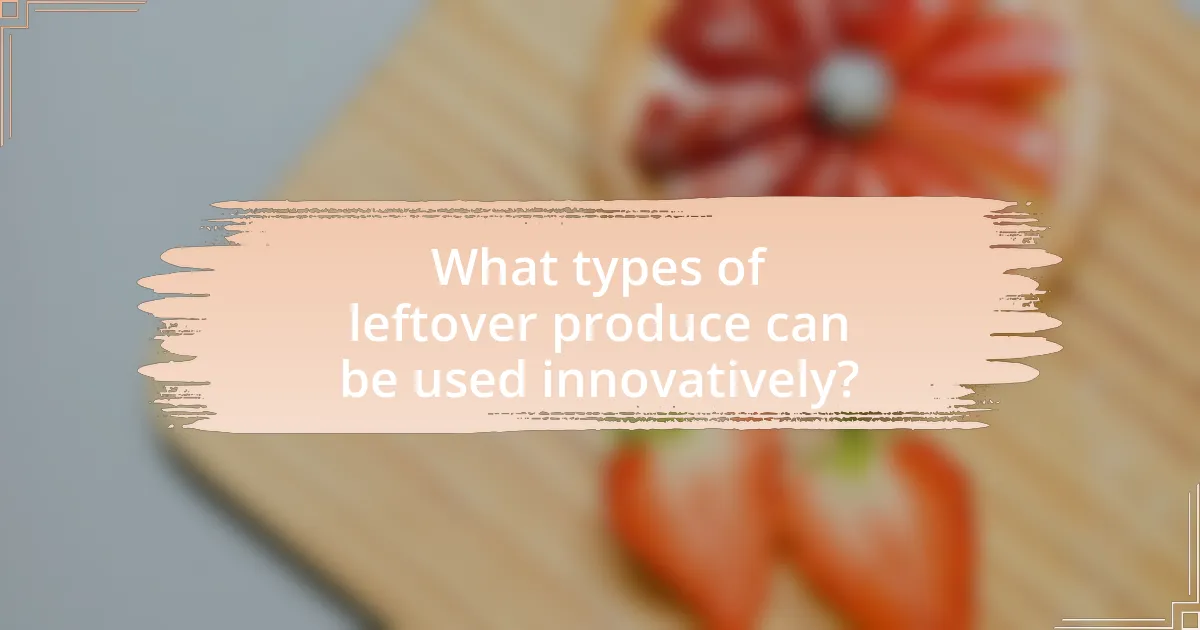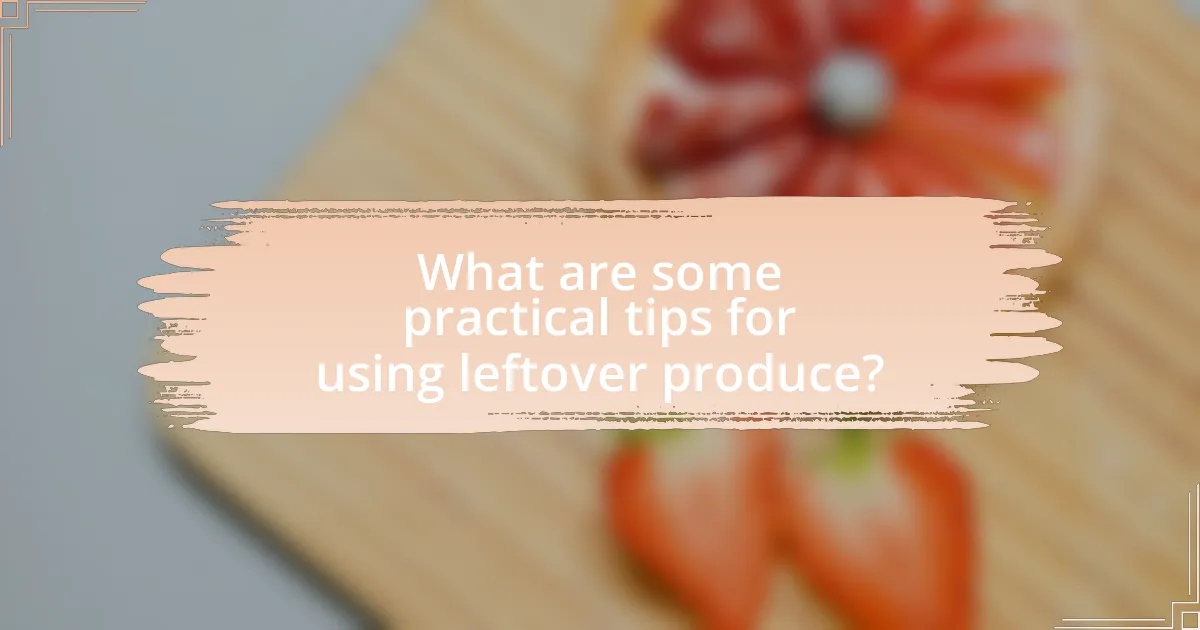The article focuses on innovative ways to utilize leftover produce from farmers markets, addressing the significant issue of food waste, which accounts for approximately 30-40% of the food supply in the U.S. It outlines various methods for repurposing fruits and vegetables, including creating preserves, smoothies, and vegetable broths, as well as techniques for preserving produce through refrigeration, freezing, canning, and pickling. The article emphasizes the environmental benefits of reducing food waste, enhancing food security, and promoting sustainability, while also providing practical tips for meal planning and storage to maximize the use of leftover produce.

What are Innovative Ways to Use Leftover Produce from Farmers Markets?
Innovative ways to use leftover produce from farmers markets include creating preserves, smoothies, and vegetable broths. Preserving fruits and vegetables through canning or pickling extends their shelf life and reduces waste. For example, overripe tomatoes can be turned into salsa or sauce, while excess berries can be made into jams. Smoothies can incorporate wilting greens and fruits that are past their prime, providing a nutritious option that minimizes waste. Additionally, vegetable broths can be made from leftover scraps, such as carrot tops and onion peels, which extract flavors and nutrients, making them a sustainable cooking base. These methods not only utilize leftover produce effectively but also contribute to reducing food waste, which is a significant issue, with approximately 30-40% of the food supply in the U.S. going uneaten.
How can leftover produce be creatively repurposed?
Leftover produce can be creatively repurposed by transforming it into various culinary and non-culinary products. For instance, overripe fruits can be made into jams, smoothies, or baked goods, while wilted vegetables can be used in soups, stocks, or stir-fries. Additionally, vegetable scraps, such as peels and stems, can be composted or used to create homemade vegetable broth, maximizing the use of the entire plant. This approach not only reduces food waste but also promotes sustainability by utilizing resources that would otherwise be discarded. According to the USDA, approximately 30-40% of the food supply in the United States is wasted, highlighting the importance of finding innovative ways to repurpose leftover produce.
What are some common methods for preserving leftover produce?
Common methods for preserving leftover produce include refrigeration, freezing, canning, pickling, and drying. Refrigeration slows down spoilage by maintaining a cool environment, while freezing halts enzymatic activity, preserving texture and nutrients. Canning involves sealing produce in jars and heating them to kill bacteria, extending shelf life significantly. Pickling uses vinegar or brine to create an acidic environment that inhibits spoilage, and drying removes moisture, preventing mold growth. These methods are widely recognized for their effectiveness in extending the usability of fruits and vegetables, ensuring minimal waste.
How can leftover produce be transformed into new dishes?
Leftover produce can be transformed into new dishes by utilizing techniques such as pickling, roasting, or blending into soups and sauces. For instance, vegetables like carrots and cucumbers can be pickled to create tangy condiments, while overripe tomatoes can be roasted to enhance their flavor and used in pasta dishes or as a base for sauces. Additionally, blending leftover fruits into smoothies or baking them into muffins can prevent waste and create nutritious meals. These methods not only reduce food waste but also encourage creativity in the kitchen, allowing for diverse culinary experiences.
Why is it important to utilize leftover produce?
Utilizing leftover produce is important because it reduces food waste and maximizes resource efficiency. According to the Food and Agriculture Organization, approximately one-third of all food produced globally is wasted, contributing to environmental degradation and economic loss. By using leftover produce, individuals and businesses can create new meals, compost, or feed animals, thereby minimizing waste and promoting sustainability. This practice not only conserves resources but also supports local economies by encouraging the use of locally sourced ingredients.
What environmental benefits come from using leftover produce?
Using leftover produce significantly reduces food waste, which is a major contributor to greenhouse gas emissions. When food is discarded, it decomposes in landfills, releasing methane, a potent greenhouse gas. By utilizing leftover produce, we can divert waste from landfills, thereby minimizing methane emissions and conserving resources used in food production, such as water and energy. According to the Food and Agriculture Organization, approximately one-third of all food produced globally is wasted, highlighting the environmental impact of food waste and the importance of using leftover produce to mitigate this issue.
How does using leftover produce contribute to food security?
Using leftover produce contributes to food security by reducing food waste and increasing the availability of nutritious food options. When leftover fruits and vegetables are utilized, they can be transformed into meals, preserved, or redistributed to communities in need, thereby enhancing access to healthy food. According to the Food and Agriculture Organization, approximately one-third of all food produced globally is wasted, which exacerbates food insecurity. By repurposing this surplus, communities can improve their food supply and ensure that more people have access to essential nutrients.

What types of leftover produce can be used innovatively?
Leftover produce that can be used innovatively includes overripe fruits, wilted greens, and vegetable scraps. Overripe fruits, such as bananas and tomatoes, can be transformed into smoothies, sauces, or baked goods, reducing waste while enhancing flavor. Wilted greens, like spinach or kale, can be blended into pesto or added to soups, maintaining nutritional value. Vegetable scraps, including carrot tops and onion peels, can be utilized to make homemade vegetable broth, maximizing the use of all parts of the produce. These practices not only minimize food waste but also encourage creative culinary applications.
How can fruits be creatively utilized after farmers markets?
Fruits can be creatively utilized after farmers markets by transforming them into preserves, smoothies, or baked goods. For instance, overripe fruits can be made into jams or jellies, which can extend their shelf life and provide a delicious spread. Additionally, blending leftover fruits into smoothies allows for a nutritious drink option, while baking them into muffins or pies offers a delightful dessert. These methods not only reduce food waste but also enhance the culinary experience by utilizing seasonal flavors.
What are some unique recipes for overripe fruits?
Unique recipes for overripe fruits include banana bread, fruit smoothies, and fruit preserves. For banana bread, overripe bananas provide natural sweetness and moisture, making it a popular choice; recipes often call for mixing mashed bananas with flour, sugar, eggs, and baking soda. Fruit smoothies utilize overripe fruits like berries or mangoes blended with yogurt or milk, creating a nutritious drink. Additionally, making fruit preserves involves cooking overripe fruits with sugar and lemon juice, resulting in a spreadable jam that captures the fruit’s flavor. These recipes effectively reduce food waste while enhancing flavor and nutrition.
How can fruits be preserved for later use?
Fruits can be preserved for later use through methods such as canning, freezing, drying, and making jams or jellies. Canning involves sealing fruits in jars and heating them to kill bacteria, which allows for long-term storage. Freezing preserves the fruit’s texture and nutrients by rapidly lowering the temperature, while drying removes moisture, inhibiting microbial growth. Making jams or jellies combines fruits with sugar and pectin, creating a shelf-stable product. These methods are effective as they have been widely used and documented for their ability to extend the shelf life of fruits significantly, often for months or even years.
What innovative uses are there for leftover vegetables?
Leftover vegetables can be innovatively used in various ways, such as creating vegetable stock, incorporating them into smoothies, or making vegetable chips. For instance, vegetable stock can be made by simmering leftover vegetables with water and herbs, which extracts flavors and nutrients, providing a base for soups and sauces. Additionally, blending leftover vegetables into smoothies can enhance nutritional value while adding unique flavors. Vegetable chips can be made by thinly slicing leftover vegetables, seasoning them, and baking until crispy, offering a healthy snack alternative. These methods not only reduce food waste but also promote creative cooking practices.
How can wilted greens be revitalized in cooking?
Wilted greens can be revitalized in cooking by soaking them in ice water for about 10 to 15 minutes. This method rehydrates the leaves, restoring their crispness and vibrant color. The cold water helps to revive the cellular structure of the greens, making them more palatable and visually appealing. Additionally, incorporating them into dishes like soups or stir-fries can enhance their texture and flavor, as the cooking process can further soften and integrate the greens into the meal.
What are some ways to incorporate leftover vegetables into meals?
Incorporating leftover vegetables into meals can be achieved through various methods such as stir-frying, adding to soups, or blending into smoothies. Stir-frying leftover vegetables with a protein source creates a quick and nutritious dish, while adding them to soups enhances flavor and nutrition, as vegetables like carrots and spinach contribute vitamins and minerals. Blending leftover vegetables into smoothies can provide a nutrient boost without altering the taste significantly, making it an easy way to consume more produce. These methods not only reduce food waste but also promote a balanced diet by utilizing the nutritional benefits of the vegetables.

What are some practical tips for using leftover produce?
To effectively use leftover produce, consider incorporating it into soups, stews, or smoothies, as these methods allow for easy blending of various ingredients. For instance, wilting greens can be added to soups for added nutrition, while overripe fruits can enhance the flavor of smoothies. Additionally, leftover vegetables can be roasted or stir-fried, maximizing their flavor and texture. According to the USDA, nearly 30-40% of the food supply in the United States is wasted, highlighting the importance of utilizing leftover produce to reduce waste and promote sustainability.
How can meal planning help in utilizing leftover produce?
Meal planning helps in utilizing leftover produce by organizing meals around the ingredients that need to be used, thereby reducing waste. By creating a structured plan, individuals can ensure that perishable items are incorporated into recipes before they spoil. Research indicates that meal planning can lead to a 50% reduction in food waste, as it encourages consumers to buy only what they need and use what they have effectively. This approach not only maximizes the use of leftover produce but also promotes healthier eating habits and cost savings.
What strategies can be employed to minimize waste at home?
To minimize waste at home, individuals can implement strategies such as meal planning, composting, and proper food storage. Meal planning helps in purchasing only necessary ingredients, reducing the likelihood of food spoilage. Composting organic waste transforms it into nutrient-rich soil, diverting waste from landfills. Proper food storage techniques, such as using airtight containers and understanding expiration dates, extend the shelf life of produce. According to the USDA, approximately 30-40% of the food supply in the United States is wasted, highlighting the importance of these strategies in reducing waste effectively.
How can community initiatives support the use of leftover produce?
Community initiatives can support the use of leftover produce by organizing food recovery programs that connect farmers with local food banks and shelters. These programs facilitate the donation of unsold fruits and vegetables, reducing food waste while providing nutritious food to those in need. For instance, the USDA reports that food recovery efforts can divert up to 30% of food waste from landfills, highlighting the effectiveness of such initiatives in addressing both hunger and waste management. Additionally, community workshops can educate residents on preserving and utilizing leftover produce, further enhancing its use and minimizing waste.
What are some best practices for storing leftover produce?
To store leftover produce effectively, keep it in a cool, dry place or refrigerate it based on the type of produce. Leafy greens should be washed, dried, and stored in a breathable container to prevent moisture buildup, while root vegetables like carrots and potatoes should be kept in a dark, cool area to avoid sprouting. Fruits such as apples and bananas should be stored separately to prevent ethylene gas from causing premature ripening. According to the USDA, proper storage can extend the shelf life of produce by several days to weeks, reducing food waste significantly.
How can proper storage extend the life of leftover produce?
Proper storage can significantly extend the life of leftover produce by maintaining optimal humidity and temperature conditions. For instance, refrigerating fruits and vegetables slows down the ripening process and reduces spoilage, as many produce items thrive in cooler environments. Additionally, using breathable bags or containers helps to regulate moisture levels, preventing mold growth and decay. Research indicates that storing leafy greens in a damp paper towel within a sealed container can keep them fresh for up to a week longer than if left unwrapped. Therefore, implementing proper storage techniques directly correlates with increased longevity of leftover produce.
What containers are best for preserving freshness?
Airtight containers are best for preserving freshness. These containers minimize air exposure, which slows down the oxidation process that leads to spoilage. Research indicates that using glass or BPA-free plastic airtight containers can extend the shelf life of fruits and vegetables by maintaining optimal humidity levels and preventing moisture loss. For example, studies show that storing leafy greens in airtight containers can keep them fresh for up to two weeks longer compared to traditional storage methods.